
Tetracyclines,Macrolides,Clindamycin,Chloramphenicol,Streptogramins Henry F.Chambers,MD INTRODUCTION The drugs described in this chapter inhibit bacterial protein synthesis by binding to and interfering with ribosomes. TETRACYCLINES Introduction All of the tetracyclines have the basic structure shown below: Free tetracyclines are crystalline amphoteric substances of low solubility.They are available as hydrochlorides,which are more soluble.Such solutions are acid and,with the exception of chlortetracycline,fairly stable.Tetracyclines chelate divalent metal ions,which can interfere with their absorption and activity.A newly approved tetracycline analog,tigecycline,is a glycylcycline and a semisynthetic derivative of minocycline. Antimicrobial Activity Tetracyclines are broad-spectrum bacteriostatic antibiotics that inhibit protein synthesis.They are active against many gram-positive and gram-negative bacteria, including anaerobes,rickettsiae,chlamydiae,mycoplasmas,and L forms;and against some protozoa,eg,amebas.The antibacterial activities of most tetracyclines are similar except that tetracycline-resistant strains may be susceptible to doxycycline, minocycline,and tigecycline,all of which are poor substrates for the efflux pump that mediates resistance.Differences in clinical efficacy for susceptible organisms are minor and attributable largely to features of absorption,distribution,and excretion of individual drugs. Tetracyclines enter microorganisms in part by passive diffusion and in part by an energy-dependent process of active transport.Susceptible cells concentrate the drug intracellularly.Once inside the cell,tetracyclines bind reversibly to the 30S subunit of the bacterial ribosome,blocking the binding of aminoacyl-tRNA to the acceptor site on the mRNA-ribosome complex (Figure 44-1).This prevents addition of amino acids to the growing peptide
Tetracyclines, Macrolides, Clindamycin, Chloramphenicol, & Streptogramins Henry F. Chambers, MD INTRODUCTION The drugs described in this chapter inhibit bacterial protein synthesis by binding to and interfering with ribosomes. TETRACYCLINES Introduction All of the tetracyclines have the basic structure shown below: Free tetracyclines are crystalline amphoteric substances of low solubility. They are available as hydrochlorides, which are more soluble. Such solutions are acid and, with the exception of chlortetracycline, fairly stable. Tetracyclines chelate divalent metal ions, which can interfere with their absorption and activity. A newly approved tetracycline analog, tigecycline, is a glycylcycline and a semisynthetic derivative of minocycline. Antimicrobial Activity Tetracyclines are broad-spectrum bacteriostatic antibiotics that inhibit protein synthesis. They are active against many gram-positive and gram-negative bacteria, including anaerobes, rickettsiae, chlamydiae, mycoplasmas, and L forms; and against some protozoa, eg, amebas. The antibacterial activities of most tetracyclines are similar except that tetracycline-resistant strains may be susceptible to doxycycline, minocycline, and tigecycline, all of which are poor substrates for the efflux pump that mediates resistance. Differences in clinical efficacy for susceptible organisms are minor and attributable largely to features of absorption, distribution, and excretion of individual drugs. Tetracyclines enter microorganisms in part by passive diffusion and in part by an energy-dependent process of active transport. Susceptible cells concentrate the drug intracellularly. Once inside the cell, tetracyclines bind reversibly to the 30S subunit of the bacterial ribosome, blocking the binding of aminoacyl-tRNA to the acceptor site on the mRNA-ribosome complex (Figure 44-1). This prevents addition of amino acids to the growing peptide
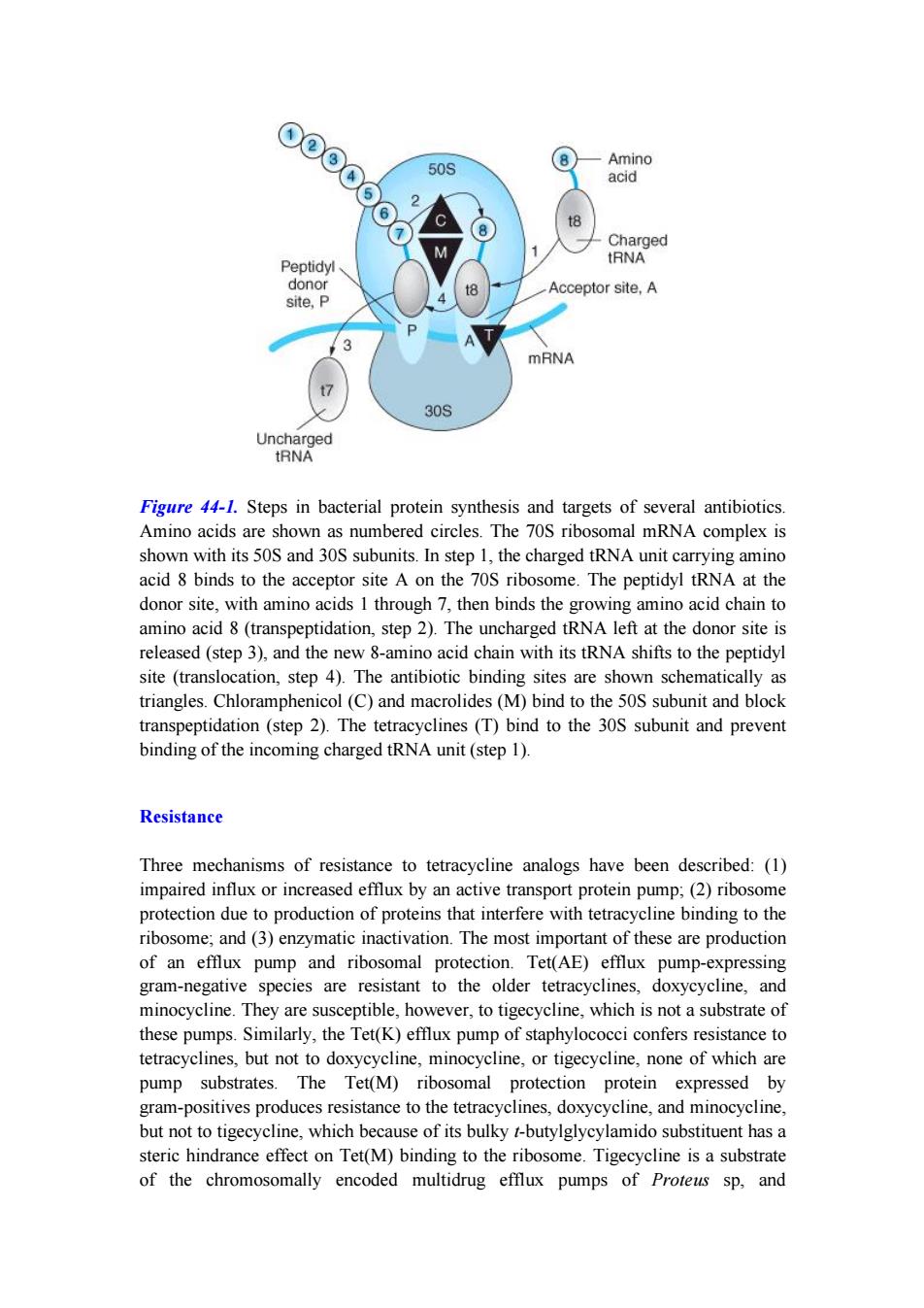
⊙@⊙ 8 Amino 50S acid (6 2 t8 Charged Peptidyl tRNA donor Acceptor site,A site,P 3 mRNA 30S Uncharged tRNA Figure 44-1.Steps in bacterial protein synthesis and targets of several antibiotics. Amino acids are shown as numbered circles.The 70S ribosomal mRNA complex is shown with its 50S and 30S subunits.In step 1,the charged tRNA unit carrying amino acid 8 binds to the acceptor site A on the 70S ribosome.The peptidyl tRNA at the donor site,with amino acids 1 through 7,then binds the growing amino acid chain to amino acid 8(transpeptidation,step 2).The uncharged tRNA left at the donor site is released(step 3),and the new 8-amino acid chain with its tRNA shifts to the peptidyl site (translocation,step 4).The antibiotic binding sites are shown schematically as triangles.Chloramphenicol(C)and macrolides(M)bind to the 50S subunit and block transpeptidation(step 2).The tetracyclines(T)bind to the 30S subunit and prevent binding of the incoming charged tRNA unit(step 1). Resistance Three mechanisms of resistance to tetracycline analogs have been described:(1) impaired influx or increased efflux by an active transport protein pump;(2)ribosome protection due to production of proteins that interfere with tetracycline binding to the ribosome;and(3)enzymatic inactivation.The most important of these are production of an efflux pump and ribosomal protection.Tet(AE)efflux pump-expressing gram-negative species are resistant to the older tetracyclines,doxycycline,and minocycline.They are susceptible,however,to tigecycline,which is not a substrate of these pumps.Similarly,the Tet(K)efflux pump of staphylococci confers resistance to tetracyclines,but not to doxycycline,minocycline,or tigecycline,none of which are pump substrates.The Tet(M)ribosomal protection protein expressed by gram-positives produces resistance to the tetracyclines,doxycycline,and minocycline, but not to tigecycline,which because of its bulky t-butylglycylamido substituent has a steric hindrance effect on Tet(M)binding to the ribosome.Tigecycline is a substrate of the chromosomally encoded multidrug efflux pumps of Proteus sp,and
Figure 44-1. Steps in bacterial protein synthesis and targets of several antibiotics. Amino acids are shown as numbered circles. The 70S ribosomal mRNA complex is shown with its 50S and 30S subunits. In step 1, the charged tRNA unit carrying amino acid 8 binds to the acceptor site A on the 70S ribosome. The peptidyl tRNA at the donor site, with amino acids 1 through 7, then binds the growing amino acid chain to amino acid 8 (transpeptidation, step 2). The uncharged tRNA left at the donor site is released (step 3), and the new 8-amino acid chain with its tRNA shifts to the peptidyl site (translocation, step 4). The antibiotic binding sites are shown schematically as triangles. Chloramphenicol (C) and macrolides (M) bind to the 50S subunit and block transpeptidation (step 2). The tetracyclines (T) bind to the 30S subunit and prevent binding of the incoming charged tRNA unit (step 1). Resistance Three mechanisms of resistance to tetracycline analogs have been described: (1) impaired influx or increased efflux by an active transport protein pump; (2) ribosome protection due to production of proteins that interfere with tetracycline binding to the ribosome; and (3) enzymatic inactivation. The most important of these are production of an efflux pump and ribosomal protection. Tet(AE) efflux pump-expressing gram-negative species are resistant to the older tetracyclines, doxycycline, and minocycline. They are susceptible, however, to tigecycline, which is not a substrate of these pumps. Similarly, the Tet(K) efflux pump of staphylococci confers resistance to tetracyclines, but not to doxycycline, minocycline, or tigecycline, none of which are pump substrates. The Tet(M) ribosomal protection protein expressed by gram-positives produces resistance to the tetracyclines, doxycycline, and minocycline, but not to tigecycline, which because of its bulky t-butylglycylamido substituent has a steric hindrance effect on Tet(M) binding to the ribosome. Tigecycline is a substrate of the chromosomally encoded multidrug efflux pumps of Proteus sp, and
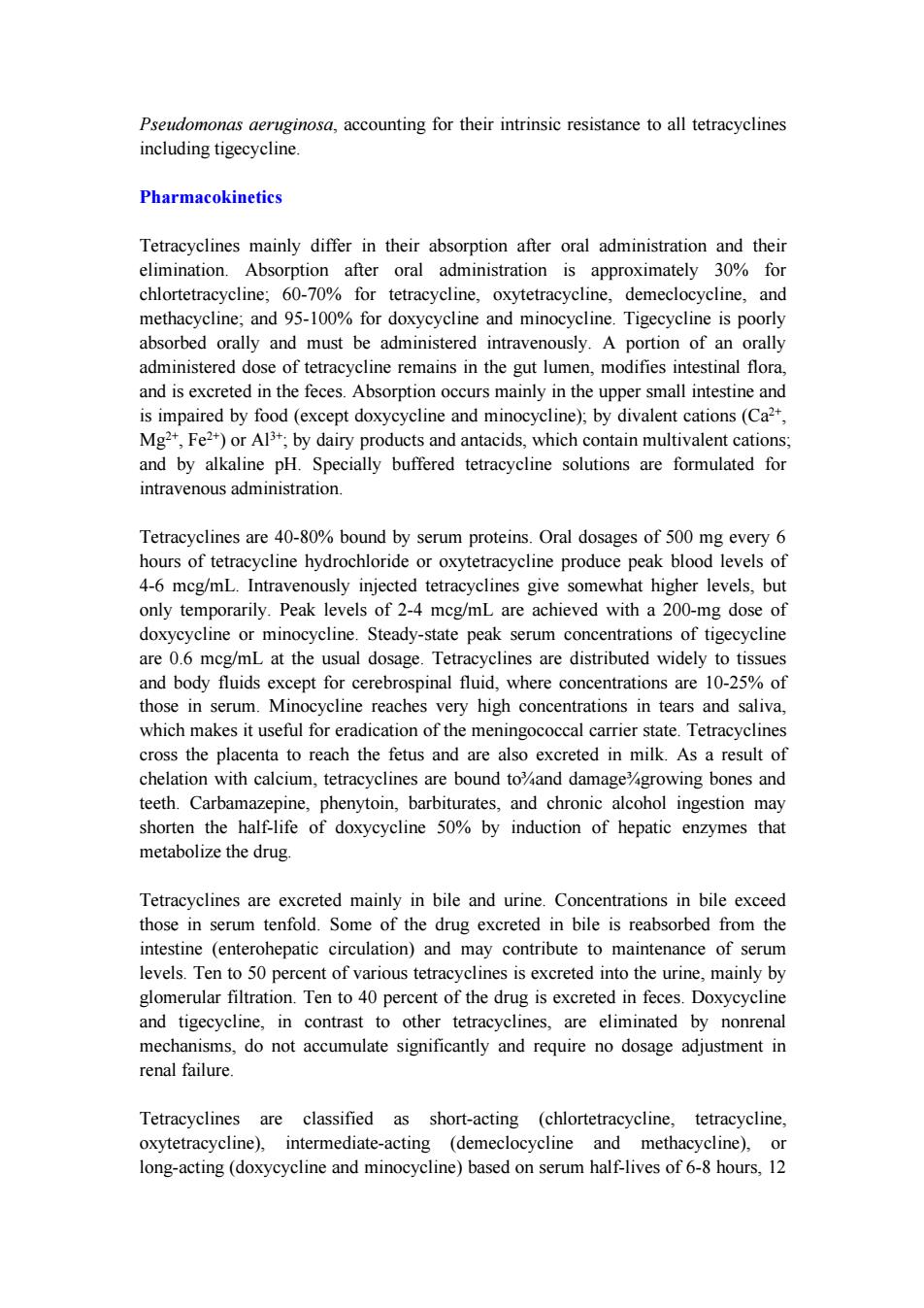
Pseudomonas aeruginosa,accounting for their intrinsic resistance to all tetracyclines including tigecycline Pharmacokinetics Tetracyclines mainly differ in their absorption after oral administration and their elimination.Absorption after oral administration is approximately 30%for chlortetracycline;60-70%for tetracycline,oxytetracycline,demeclocycline,and methacycline;and 95-100%for doxycycline and minocycline.Tigecycline is poorly absorbed orally and must be administered intravenously.A portion of an orally administered dose of tetracycline remains in the gut lumen,modifies intestinal flora, and is excreted in the feces.Absorption occurs mainly in the upper small intestine and is impaired by food (except doxycycline and minocycline);by divalent cations(Ca2+, Mg2+,Fe2+)or Al3+;by dairy products and antacids,which contain multivalent cations; and by alkaline pH.Specially buffered tetracycline solutions are formulated for intravenous administration. Tetracyclines are 40-80%bound by serum proteins.Oral dosages of 500 mg every 6 hours of tetracycline hydrochloride or oxytetracycline produce peak blood levels of 4-6 mcg/mL.Intravenously injected tetracyclines give somewhat higher levels,but only temporarily.Peak levels of 2-4 mcg/mL are achieved with a 200-mg dose of doxycycline or minocycline.Steady-state peak serum concentrations of tigecycline are 0.6 mcg/mL at the usual dosage.Tetracyclines are distributed widely to tissues and body fluids except for cerebrospinal fluid,where concentrations are 10-25%of those in serum.Minocycline reaches very high concentrations in tears and saliva, which makes it useful for eradication of the meningococcal carrier state.Tetracyclines cross the placenta to reach the fetus and are also excreted in milk.As a result of chelation with calcium,tetracyclines are bound to and damage%growing bones and teeth.Carbamazepine,phenytoin,barbiturates,and chronic alcohol ingestion may shorten the half-life of doxycycline 50%by induction of hepatic enzymes that metabolize the drug. Tetracyclines are excreted mainly in bile and urine.Concentrations in bile exceed those in serum tenfold.Some of the drug excreted in bile is reabsorbed from the intestine (enterohepatic circulation)and may contribute to maintenance of serum levels.Ten to 50 percent of various tetracyclines is excreted into the urine,mainly by glomerular filtration.Ten to 40 percent of the drug is excreted in feces.Doxycycline and tigecycline,in contrast to other tetracyclines,are eliminated by nonrenal mechanisms,do not accumulate significantly and require no dosage adjustment in renal failure Tetracyclines are classified as short-acting (chlortetracycline,tetracycline, oxytetracycline),intermediate-acting (demeclocycline and methacycline),or long-acting(doxycycline and minocycline)based on serum half-lives of 6-8 hours,12
Pseudomonas aeruginosa, accounting for their intrinsic resistance to all tetracyclines including tigecycline. Pharmacokinetics Tetracyclines mainly differ in their absorption after oral administration and their elimination. Absorption after oral administration is approximately 30% for chlortetracycline; 60-70% for tetracycline, oxytetracycline, demeclocycline, and methacycline; and 95-100% for doxycycline and minocycline. Tigecycline is poorly absorbed orally and must be administered intravenously. A portion of an orally administered dose of tetracycline remains in the gut lumen, modifies intestinal flora, and is excreted in the feces. Absorption occurs mainly in the upper small intestine and is impaired by food (except doxycycline and minocycline); by divalent cations (Ca 2+ , Mg 2+ , Fe 2+ ) or Al3+ ; by dairy products and antacids, which contain multivalent cations; and by alkaline pH. Specially buffered tetracycline solutions are formulated for intravenous administration. Tetracyclines are 40-80% bound by serum proteins. Oral dosages of 500 mg every 6 hours of tetracycline hydrochloride or oxytetracycline produce peak blood levels of 4-6 mcg/mL. Intravenously injected tetracyclines give somewhat higher levels, but only temporarily. Peak levels of 2-4 mcg/mL are achieved with a 200-mg dose of doxycycline or minocycline. Steady-state peak serum concentrations of tigecycline are 0.6 mcg/mL at the usual dosage. Tetracyclines are distributed widely to tissues and body fluids except for cerebrospinal fluid, where concentrations are 10-25% of those in serum. Minocycline reaches very high concentrations in tears and saliva, which makes it useful for eradication of the meningococcal carrier state. Tetracyclines cross the placenta to reach the fetus and are also excreted in milk. As a result of chelation with calcium, tetracyclines are bound to¾and damage¾growing bones and teeth. Carbamazepine, phenytoin, barbiturates, and chronic alcohol ingestion may shorten the half-life of doxycycline 50% by induction of hepatic enzymes that metabolize the drug. Tetracyclines are excreted mainly in bile and urine. Concentrations in bile exceed those in serum tenfold. Some of the drug excreted in bile is reabsorbed from the intestine (enterohepatic circulation) and may contribute to maintenance of serum levels. Ten to 50 percent of various tetracyclines is excreted into the urine, mainly by glomerular filtration. Ten to 40 percent of the drug is excreted in feces. Doxycycline and tigecycline, in contrast to other tetracyclines, are eliminated by nonrenal mechanisms, do not accumulate significantly and require no dosage adjustment in renal failure. Tetracyclines are classified as short-acting (chlortetracycline, tetracycline, oxytetracycline), intermediate-acting (demeclocycline and methacycline), or long-acting (doxycycline and minocycline) based on serum half-lives of 6-8 hours, 12
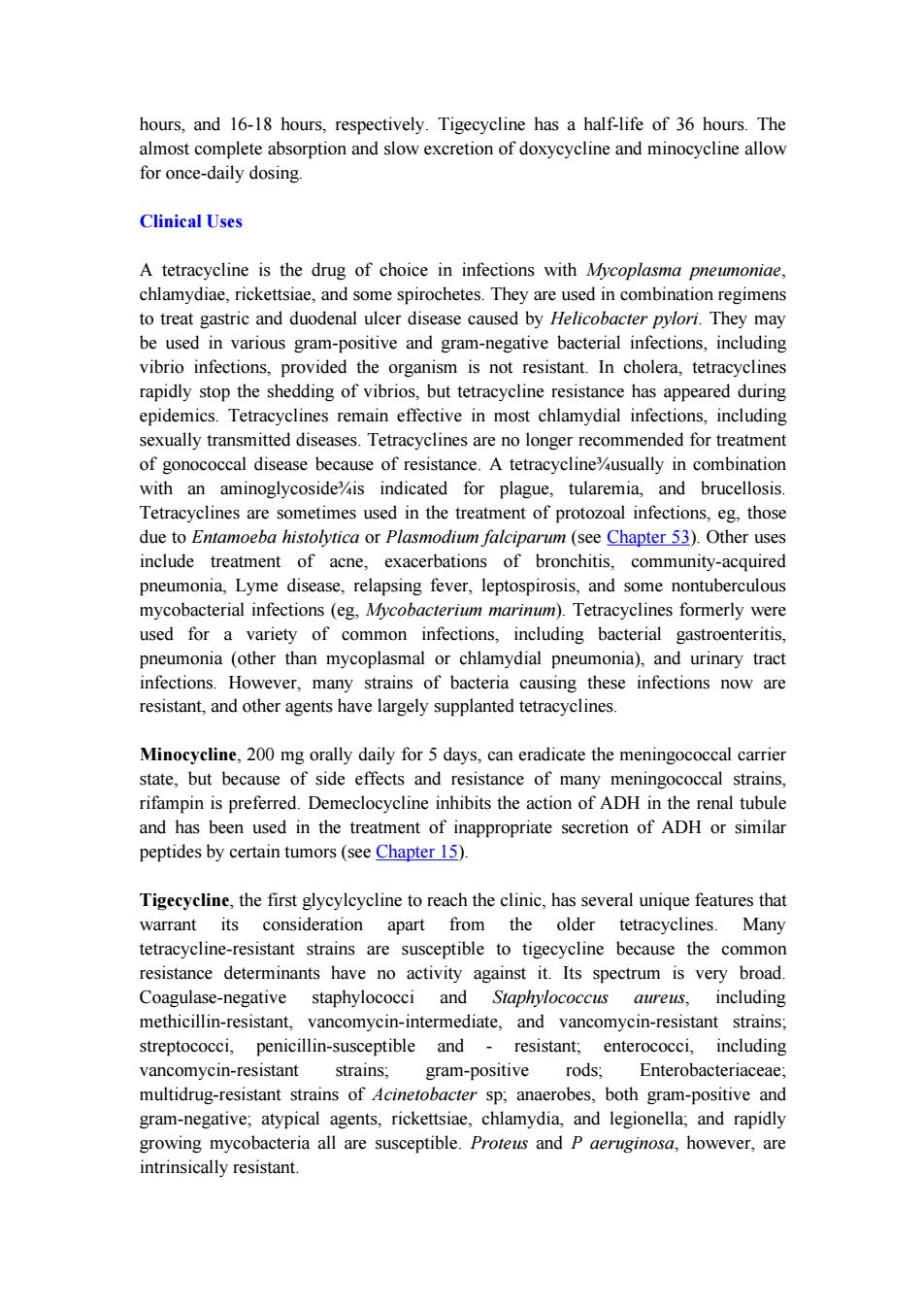
hours,and 16-18 hours,respectively.Tigecycline has a half-life of 36 hours.The almost complete absorption and slow excretion of doxycycline and minocycline allow for once-daily dosing. Clinical Uses A tetracycline is the drug of choice in infections with Mycoplasma pneumoniae, chlamydiae,rickettsiae,and some spirochetes.They are used in combination regimens to treat gastric and duodenal ulcer disease caused by Helicobacter pylori.They may be used in various gram-positive and gram-negative bacterial infections,including vibrio infections,provided the organism is not resistant.In cholera,tetracyclines rapidly stop the shedding of vibrios,but tetracycline resistance has appeared during epidemics.Tetracyclines remain effective in most chlamydial infections,including sexually transmitted diseases.Tetracyclines are no longer recommended for treatment of gonococcal disease because of resistance.A tetracycline%usually in combination with an aminoglycosideis indicated for plague,tularemia,and brucellosis. Tetracyclines are sometimes used in the treatment of protozoal infections,eg,those due to Entamoeba histolytica or Plasmodium falciparum (see Chapter 53).Other uses include treatment of acne,exacerbations of bronchitis,community-acquired pneumonia,Lyme disease,relapsing fever,leptospirosis,and some nontuberculous mycobacterial infections(eg,Mycobacterium marinum).Tetracyclines formerly were used for a variety of common infections,including bacterial gastroenteritis, pneumonia (other than mycoplasmal or chlamydial pneumonia),and urinary tract infections.However,many strains of bacteria causing these infections now are resistant,and other agents have largely supplanted tetracyclines. Minocycline,200 mg orally daily for 5 days,can eradicate the meningococcal carrier state,but because of side effects and resistance of many meningococcal strains, rifampin is preferred.Demeclocycline inhibits the action of ADH in the renal tubule and has been used in the treatment of inappropriate secretion of ADH or similar peptides by certain tumors(see Chapter 15). Tigecycline,the first glycylcycline to reach the clinic,has several unique features that warrant its consideration apart from the older tetracyclines.Many tetracycline-resistant strains are susceptible to tigecycline because the common resistance determinants have no activity against it.Its spectrum is very broad. Coagulase-negative staphylococci and Staphylococcus aureus,including methicillin-resistant,vancomycin-intermediate,and vancomycin-resistant strains; streptococci,penicillin-susceptible and-resistant;enterococci,including vancomycin-resistant strains;gram-positive rods;Enterobacteriaceae; multidrug-resistant strains of Acinetobacter sp;anaerobes,both gram-positive and gram-negative;atypical agents,rickettsiae,chlamydia,and legionella;and rapidly growing mycobacteria all are susceptible.Proteus and P aeruginosa,however,are intrinsically resistant
hours, and 16-18 hours, respectively. Tigecycline has a half-life of 36 hours. The almost complete absorption and slow excretion of doxycycline and minocycline allow for once-daily dosing. Clinical Uses A tetracycline is the drug of choice in infections with Mycoplasma pneumoniae, chlamydiae, rickettsiae, and some spirochetes. They are used in combination regimens to treat gastric and duodenal ulcer disease caused by Helicobacter pylori. They may be used in various gram-positive and gram-negative bacterial infections, including vibrio infections, provided the organism is not resistant. In cholera, tetracyclines rapidly stop the shedding of vibrios, but tetracycline resistance has appeared during epidemics. Tetracyclines remain effective in most chlamydial infections, including sexually transmitted diseases. Tetracyclines are no longer recommended for treatment of gonococcal disease because of resistance. A tetracycline¾usually in combination with an aminoglycoside¾is indicated for plague, tularemia, and brucellosis. Tetracyclines are sometimes used in the treatment of protozoal infections, eg, those due to Entamoeba histolytica or Plasmodium falciparum (see Chapter 53). Other uses include treatment of acne, exacerbations of bronchitis, community-acquired pneumonia, Lyme disease, relapsing fever, leptospirosis, and some nontuberculous mycobacterial infections (eg, Mycobacterium marinum). Tetracyclines formerly were used for a variety of common infections, including bacterial gastroenteritis, pneumonia (other than mycoplasmal or chlamydial pneumonia), and urinary tract infections. However, many strains of bacteria causing these infections now are resistant, and other agents have largely supplanted tetracyclines. Minocycline, 200 mg orally daily for 5 days, can eradicate the meningococcal carrier state, but because of side effects and resistance of many meningococcal strains, rifampin is preferred. Demeclocycline inhibits the action of ADH in the renal tubule and has been used in the treatment of inappropriate secretion of ADH or similar peptides by certain tumors (see Chapter 15). Tigecycline, the first glycylcycline to reach the clinic, has several unique features that warrant its consideration apart from the older tetracyclines. Many tetracycline-resistant strains are susceptible to tigecycline because the common resistance determinants have no activity against it. Its spectrum is very broad. Coagulase-negative staphylococci and Staphylococcus aureus, including methicillin-resistant, vancomycin-intermediate, and vancomycin-resistant strains; streptococci, penicillin-susceptible and - resistant; enterococci, including vancomycin-resistant strains; gram-positive rods; Enterobacteriaceae; multidrug-resistant strains of Acinetobacter sp; anaerobes, both gram-positive and gram-negative; atypical agents, rickettsiae, chlamydia, and legionella; and rapidly growing mycobacteria all are susceptible. Proteus and P aeruginosa, however, are intrinsically resistant
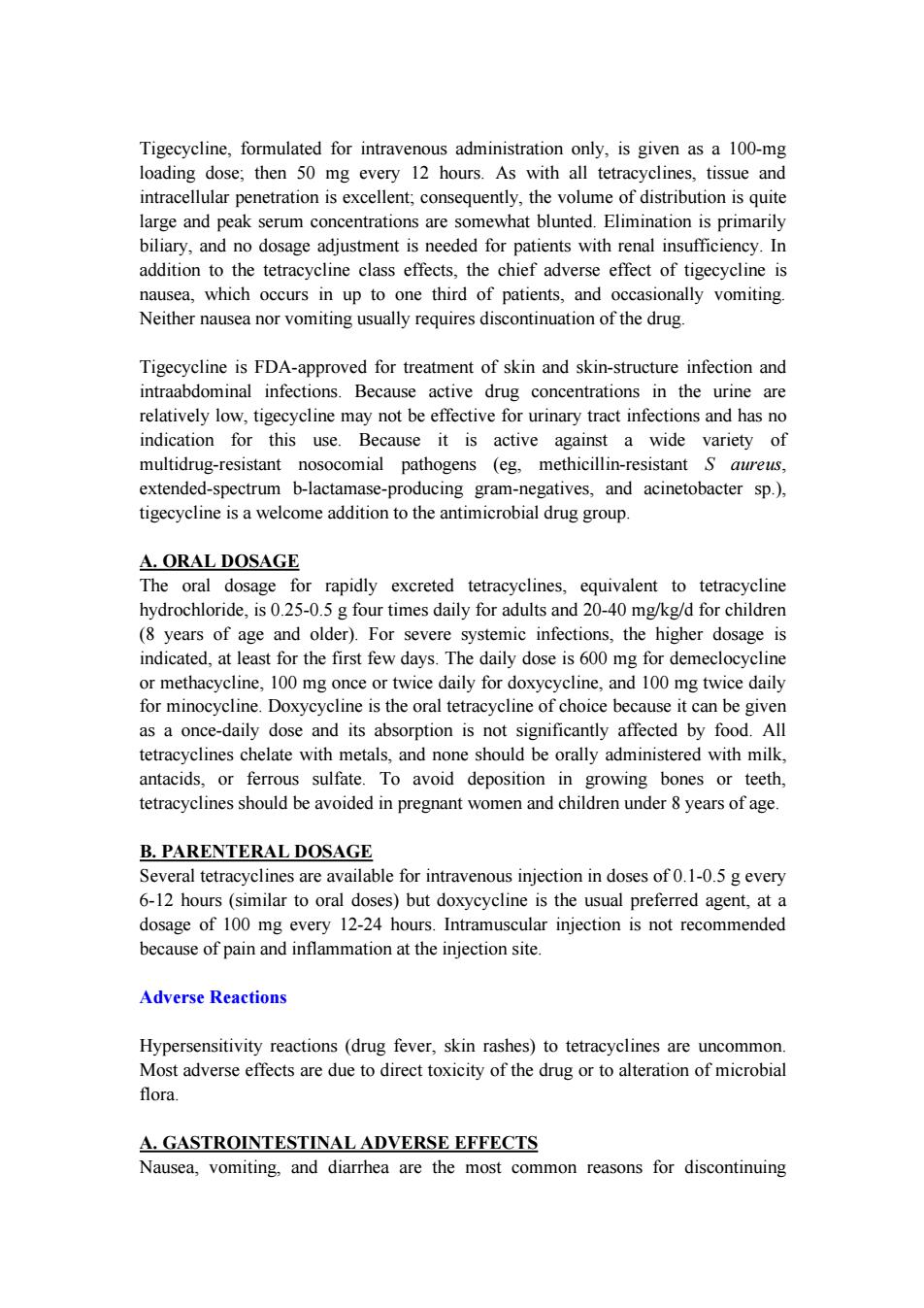
Tigecycline,formulated for intravenous administration only,is given as a 100-mg loading dose;then 50 mg every 12 hours.As with all tetracyclines,tissue and intracellular penetration is excellent;consequently,the volume of distribution is quite large and peak serum concentrations are somewhat blunted.Elimination is primarily biliary,and no dosage adjustment is needed for patients with renal insufficiency.In addition to the tetracycline class effects,the chief adverse effect of tigecycline is nausea,which occurs in up to one third of patients,and occasionally vomiting. Neither nausea nor vomiting usually requires discontinuation of the drug. Tigecycline is FDA-approved for treatment of skin and skin-structure infection and intraabdominal infections.Because active drug concentrations in the urine are relatively low,tigecycline may not be effective for urinary tract infections and has no indication for this use.Because it is active against a wide variety of multidrug-resistant nosocomial pathogens (eg,methicillin-resistant S aureus, extended-spectrum b-lactamase-producing gram-negatives,and acinetobacter sp.), tigecycline is a welcome addition to the antimicrobial drug group A.ORAL DOSAGE The oral dosage for rapidly excreted tetracyclines,equivalent to tetracycline hydrochloride,is 0.25-0.5 g four times daily for adults and 20-40 mg/kg/d for children (8 years of age and older).For severe systemic infections,the higher dosage is indicated,at least for the first few days.The daily dose is 600 mg for demeclocycline or methacycline,100 mg once or twice daily for doxycycline,and 100 mg twice daily for minocycline.Doxycycline is the oral tetracycline of choice because it can be given as a once-daily dose and its absorption is not significantly affected by food.All tetracyclines chelate with metals,and none should be orally administered with milk, antacids,or ferrous sulfate.To avoid deposition in growing bones or teeth, tetracyclines should be avoided in pregnant women and children under 8 years of age. B.PARENTERAL DOSAGE Several tetracyclines are available for intravenous injection in doses of 0.1-0.5 g every 6-12 hours (similar to oral doses)but doxycycline is the usual preferred agent,at a dosage of 100 mg every 12-24 hours.Intramuscular injection is not recommended because of pain and inflammation at the injection site Adverse Reactions Hypersensitivity reactions(drug fever,skin rashes)to tetracyclines are uncommon. Most adverse effects are due to direct toxicity of the drug or to alteration of microbial flora A.GASTROINTESTINAL ADVERSE EFFECTS Nausea,vomiting,and diarrhea are the most common reasons for discontinuing
Tigecycline, formulated for intravenous administration only, is given as a 100-mg loading dose; then 50 mg every 12 hours. As with all tetracyclines, tissue and intracellular penetration is excellent; consequently, the volume of distribution is quite large and peak serum concentrations are somewhat blunted. Elimination is primarily biliary, and no dosage adjustment is needed for patients with renal insufficiency. In addition to the tetracycline class effects, the chief adverse effect of tigecycline is nausea, which occurs in up to one third of patients, and occasionally vomiting. Neither nausea nor vomiting usually requires discontinuation of the drug. Tigecycline is FDA-approved for treatment of skin and skin-structure infection and intraabdominal infections. Because active drug concentrations in the urine are relatively low, tigecycline may not be effective for urinary tract infections and has no indication for this use. Because it is active against a wide variety of multidrug-resistant nosocomial pathogens (eg, methicillin-resistant S aureus, extended-spectrum b-lactamase-producing gram-negatives, and acinetobacter sp.), tigecycline is a welcome addition to the antimicrobial drug group. A. ORAL DOSAGE The oral dosage for rapidly excreted tetracyclines, equivalent to tetracycline hydrochloride, is 0.25-0.5 g four times daily for adults and 20-40 mg/kg/d for children (8 years of age and older). For severe systemic infections, the higher dosage is indicated, at least for the first few days. The daily dose is 600 mg for demeclocycline or methacycline, 100 mg once or twice daily for doxycycline, and 100 mg twice daily for minocycline. Doxycycline is the oral tetracycline of choice because it can be given as a once-daily dose and its absorption is not significantly affected by food. All tetracyclines chelate with metals, and none should be orally administered with milk, antacids, or ferrous sulfate. To avoid deposition in growing bones or teeth, tetracyclines should be avoided in pregnant women and children under 8 years of age. B. PARENTERAL DOSAGE Several tetracyclines are available for intravenous injection in doses of 0.1-0.5 g every 6-12 hours (similar to oral doses) but doxycycline is the usual preferred agent, at a dosage of 100 mg every 12-24 hours. Intramuscular injection is not recommended because of pain and inflammation at the injection site. Adverse Reactions Hypersensitivity reactions (drug fever, skin rashes) to tetracyclines are uncommon. Most adverse effects are due to direct toxicity of the drug or to alteration of microbial flora. A. GASTROINTESTINAL ADVERSE EFFECTS Nausea, vomiting, and diarrhea are the most common reasons for discontinuing

tetracycline medication.These effects are attributable to direct local irritation of the intestinal tract.Nausea,anorexia,and diarrhea can usually be controlled by administering the drug with food or carboxymethylcellulose,reducing drug dosage,or discontinuing the drug. Tetracyclines modify the normal flora,with suppression of susceptible coliform organisms and overgrowth of pseudomonas,proteus,staphylococci,resistant coliforms,clostridia,and candida.This can result in intestinal functional disturbances, anal pruritus,vaginal or oral candidiasis,or enterocolitis with shock and death. B.BONY STRUCTURES AND TEETH Tetracyclines are readily bound to calcium deposited in newly formed bone or teeth in young children.When a tetracycline is given during pregnancy,it can be deposited in the fetal teeth,leading to fluorescence,discoloration,and enamel dysplasia;it can also be deposited in bone,where it may cause deformity or growth inhibition.If the drug is given for long periods to children under 8 years of age,similar changes can result. C.LIVER TOXICITY Tetracyclines can probably impair hepatic function,especially during pregnancy,in patients with preexisting hepatic insufficiency and when high doses are given intravenously.Hepatic necrosis has been reported with daily doses of 4 g or more intravenously. D.KIDNEY TOXICITY Renal tubular acidosis and other renal injury resulting in nitrogen retention have been attributed to the administration of outdated tetracycline preparations.Tetracyclines given along with diuretics may produce nitrogen retention.Tetracyclines other than doxycycline may accumulate to toxic levels in patients with impaired kidney function. E.LOCAL TISSUE TOXICITY Intravenous injection can lead to venous thrombosis.Intramuscular injection produces painful local irritation and should be avoided. F.PHOTOSENSITIZATION Systemically administered tetracycline,especially demeclocycline,can induce sensitivity to sunlight or ultraviolet light,particularly in fair-skinned persons. G.VESTIBULAR REACTIONS Dizziness,vertigo,nausea,and vomiting have been noted particularly with doxycycline at doses above 100 mg.With dosages of 200-400 mg/d of minocycline, 35-70%of patients will have these reactions. MACROLIDES
tetracycline medication. These effects are attributable to direct local irritation of the intestinal tract. Nausea, anorexia, and diarrhea can usually be controlled by administering the drug with food or carboxymethylcellulose, reducing drug dosage, or discontinuing the drug. Tetracyclines modify the normal flora, with suppression of susceptible coliform organisms and overgrowth of pseudomonas, proteus, staphylococci, resistant coliforms, clostridia, and candida. This can result in intestinal functional disturbances, anal pruritus, vaginal or oral candidiasis, or enterocolitis with shock and death. B. BONY STRUCTURES AND TEETH Tetracyclines are readily bound to calcium deposited in newly formed bone or teeth in young children. When a tetracycline is given during pregnancy, it can be deposited in the fetal teeth, leading to fluorescence, discoloration, and enamel dysplasia; it can also be deposited in bone, where it may cause deformity or growth inhibition. If the drug is given for long periods to children under 8 years of age, similar changes can result. C. LIVER TOXICITY Tetracyclines can probably impair hepatic function, especially during pregnancy, in patients with preexisting hepatic insufficiency and when high doses are given intravenously. Hepatic necrosis has been reported with daily doses of 4 g or more intravenously. D. KIDNEY TOXICITY Renal tubular acidosis and other renal injury resulting in nitrogen retention have been attributed to the administration of outdated tetracycline preparations. Tetracyclines given along with diuretics may produce nitrogen retention. Tetracyclines other than doxycycline may accumulate to toxic levels in patients with impaired kidney function. E. LOCAL TISSUE TOXICITY Intravenous injection can lead to venous thrombosis. Intramuscular injection produces painful local irritation and should be avoided. F. PHOTOSENSITIZATION Systemically administered tetracycline, especially demeclocycline, can induce sensitivity to sunlight or ultraviolet light, particularly in fair-skinned persons. G. VESTIBULAR REACTIONS Dizziness, vertigo, nausea, and vomiting have been noted particularly with doxycycline at doses above 100 mg. With dosages of 200-400 mg/d of minocycline, 35-70% of patients will have these reactions. MACROLIDES
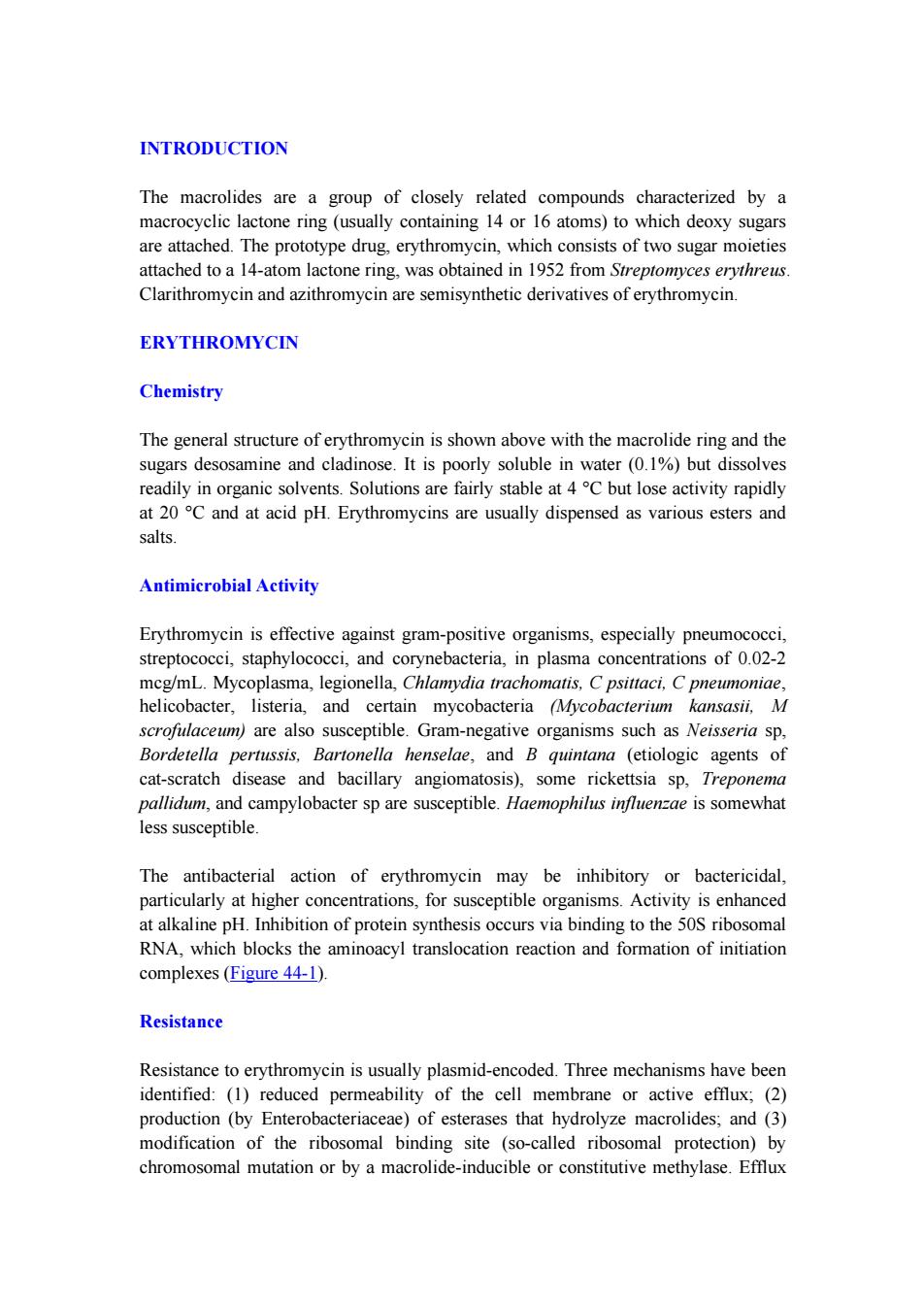
INTRODUCTION The macrolides are a group of closely related compounds characterized by a macrocyclic lactone ring (usually containing 14 or 16 atoms)to which deoxy sugars are attached.The prototype drug,erythromycin,which consists of two sugar moieties attached to a 14-atom lactone ring,was obtained in 1952 from Streptomyces erythreus. Clarithromycin and azithromycin are semisynthetic derivatives of erythromycin. ERYTHROMYCIN Chemistry The general structure of erythromycin is shown above with the macrolide ring and the sugars desosamine and cladinose.It is poorly soluble in water (0.1%)but dissolves readily in organic solvents.Solutions are fairly stable at 4 C but lose activity rapidly at 20 C and at acid pH.Erythromycins are usually dispensed as various esters and salts. Antimicrobial Activity Erythromycin is effective against gram-positive organisms,especially pneumococci, streptococci,staphylococci,and corynebacteria,in plasma concentrations of 0.02-2 mcg/mL.Mycoplasma,legionella,Chlamydia trachomatis,C psittaci,C pneumoniae, helicobacter,listeria,and certain mycobacteria (Mycobacterium kansasii,M scrofulaceum)are also susceptible.Gram-negative organisms such as Neisseria sp, Bordetella pertussis,Bartonella henselae,and B quintana (etiologic agents of cat-scratch disease and bacillary angiomatosis),some rickettsia sp,Treponema pallidum,and campylobacter sp are susceptible.Haemophilus influenzae is somewhat less susceptible. The antibacterial action of erythromycin may be inhibitory or bactericidal, particularly at higher concentrations,for susceptible organisms.Activity is enhanced at alkaline pH.Inhibition of protein synthesis occurs via binding to the 50S ribosomal RNA,which blocks the aminoacyl translocation reaction and formation of initiation complexes (Figure 44-1). Resistance Resistance to erythromycin is usually plasmid-encoded.Three mechanisms have been identified:(1)reduced permeability of the cell membrane or active efflux;(2) production (by Enterobacteriaceae)of esterases that hydrolyze macrolides;and (3) modification of the ribosomal binding site (so-called ribosomal protection)by chromosomal mutation or by a macrolide-inducible or constitutive methylase.Efflux
INTRODUCTION The macrolides are a group of closely related compounds characterized by a macrocyclic lactone ring (usually containing 14 or 16 atoms) to which deoxy sugars are attached. The prototype drug, erythromycin, which consists of two sugar moieties attached to a 14-atom lactone ring, was obtained in 1952 from Streptomyces erythreus. Clarithromycin and azithromycin are semisynthetic derivatives of erythromycin. ERYTHROMYCIN Chemistry The general structure of erythromycin is shown above with the macrolide ring and the sugars desosamine and cladinose. It is poorly soluble in water (0.1%) but dissolves readily in organic solvents. Solutions are fairly stable at 4 °C but lose activity rapidly at 20 °C and at acid pH. Erythromycins are usually dispensed as various esters and salts. Antimicrobial Activity Erythromycin is effective against gram-positive organisms, especially pneumococci, streptococci, staphylococci, and corynebacteria, in plasma concentrations of 0.02-2 mcg/mL. Mycoplasma, legionella, Chlamydia trachomatis, C psittaci, C pneumoniae, helicobacter, listeria, and certain mycobacteria (Mycobacterium kansasii, M scrofulaceum) are also susceptible. Gram-negative organisms such as Neisseria sp, Bordetella pertussis, Bartonella henselae, and B quintana (etiologic agents of cat-scratch disease and bacillary angiomatosis), some rickettsia sp, Treponema pallidum, and campylobacter sp are susceptible. Haemophilus influenzae is somewhat less susceptible. The antibacterial action of erythromycin may be inhibitory or bactericidal, particularly at higher concentrations, for susceptible organisms. Activity is enhanced at alkaline pH. Inhibition of protein synthesis occurs via binding to the 50S ribosomal RNA, which blocks the aminoacyl translocation reaction and formation of initiation complexes (Figure 44-1). Resistance Resistance to erythromycin is usually plasmid-encoded. Three mechanisms have been identified: (1) reduced permeability of the cell membrane or active efflux; (2) production (by Enterobacteriaceae) of esterases that hydrolyze macrolides; and (3) modification of the ribosomal binding site (so-called ribosomal protection) by chromosomal mutation or by a macrolide-inducible or constitutive methylase. Efflux
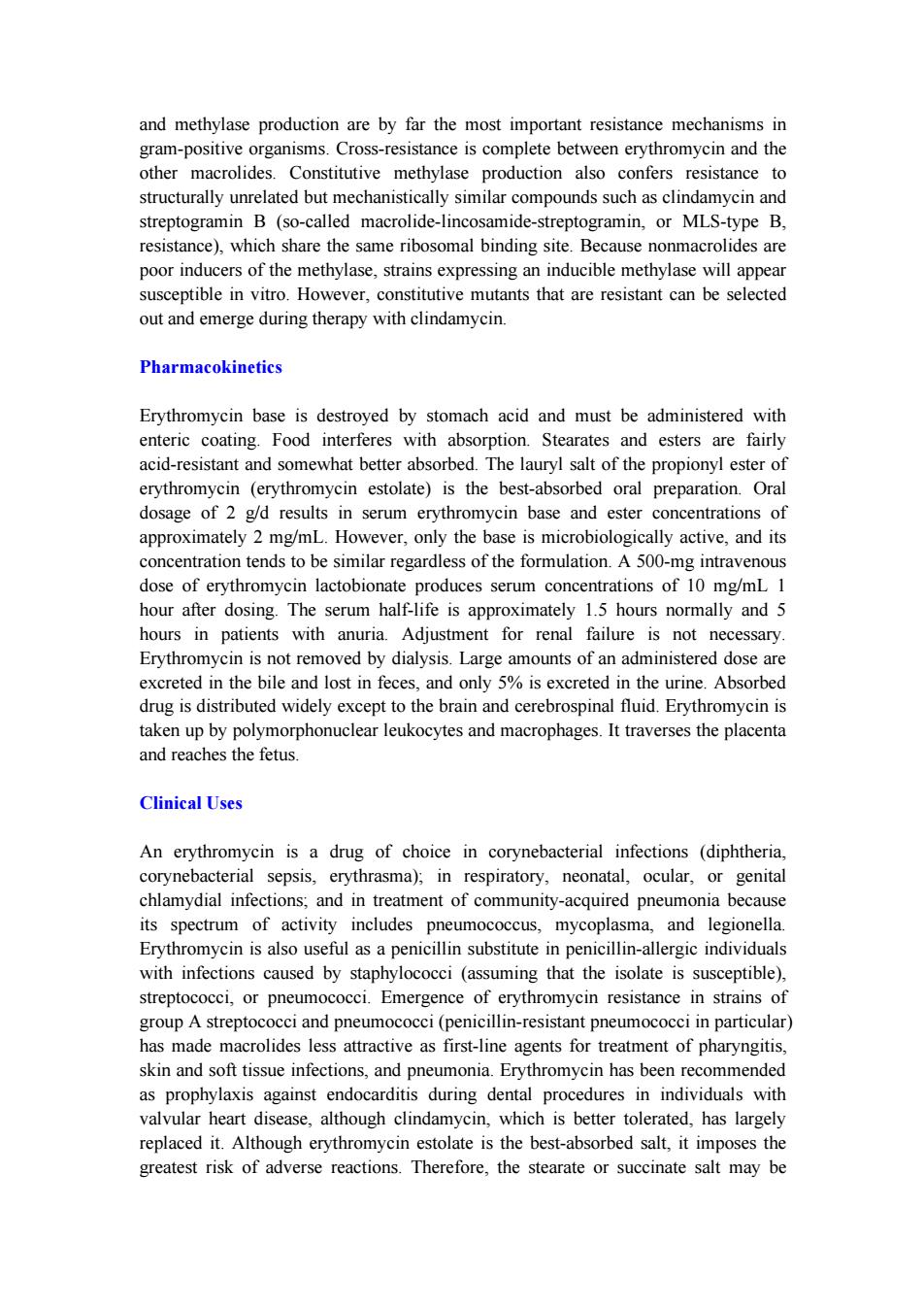
and methylase production are by far the most important resistance mechanisms in gram-positive organisms.Cross-resistance is complete between erythromycin and the other macrolides.Constitutive methylase production also confers resistance to structurally unrelated but mechanistically similar compounds such as clindamycin and streptogramin B(so-called macrolide-lincosamide-streptogramin,or MLS-type B, resistance),which share the same ribosomal binding site.Because nonmacrolides are poor inducers of the methylase,strains expressing an inducible methylase will appear susceptible in vitro.However,constitutive mutants that are resistant can be selected out and emerge during therapy with clindamycin. Pharmacokinetics Erythromycin base is destroyed by stomach acid and must be administered with enteric coating.Food interferes with absorption.Stearates and esters are fairly acid-resistant and somewhat better absorbed.The lauryl salt of the propionyl ester of erythromycin (erythromycin estolate)is the best-absorbed oral preparation.Oral dosage of 2 g/d results in serum erythromycin base and ester concentrations of approximately 2 mg/mL.However,only the base is microbiologically active,and its concentration tends to be similar regardless of the formulation.A 500-mg intravenous dose of erythromycin lactobionate produces serum concentrations of 10 mg/mL 1 hour after dosing.The serum half-life is approximately 1.5 hours normally and 5 hours in patients with anuria.Adjustment for renal failure is not necessary. Erythromycin is not removed by dialysis.Large amounts of an administered dose are excreted in the bile and lost in feces,and only 5%is excreted in the urine.Absorbed drug is distributed widely except to the brain and cerebrospinal fluid.Erythromycin is taken up by polymorphonuclear leukocytes and macrophages.It traverses the placenta and reaches the fetus. Clinical Uses An erythromycin is a drug of choice in corynebacterial infections (diphtheria. corynebacterial sepsis,erythrasma);in respiratory,neonatal,ocular,or genital chlamydial infections;and in treatment of community-acquired pneumonia because its spectrum of activity includes pneumococcus,mycoplasma,and legionella. Erythromycin is also useful as a penicillin substitute in penicillin-allergic individuals with infections caused by staphylococci (assuming that the isolate is susceptible), streptococci,or pneumococci.Emergence of erythromycin resistance in strains of group A streptococci and pneumococci(penicillin-resistant pneumococci in particular) has made macrolides less attractive as first-line agents for treatment of pharyngitis, skin and soft tissue infections,and pneumonia.Erythromycin has been recommended as prophylaxis against endocarditis during dental procedures in individuals with valvular heart disease,although clindamycin,which is better tolerated,has largely replaced it.Although erythromycin estolate is the best-absorbed salt,it imposes the greatest risk of adverse reactions.Therefore,the stearate or succinate salt may be
and methylase production are by far the most important resistance mechanisms in gram-positive organisms. Cross-resistance is complete between erythromycin and the other macrolides. Constitutive methylase production also confers resistance to structurally unrelated but mechanistically similar compounds such as clindamycin and streptogramin B (so-called macrolide-lincosamide-streptogramin, or MLS-type B, resistance), which share the same ribosomal binding site. Because nonmacrolides are poor inducers of the methylase, strains expressing an inducible methylase will appear susceptible in vitro. However, constitutive mutants that are resistant can be selected out and emerge during therapy with clindamycin. Pharmacokinetics Erythromycin base is destroyed by stomach acid and must be administered with enteric coating. Food interferes with absorption. Stearates and esters are fairly acid-resistant and somewhat better absorbed. The lauryl salt of the propionyl ester of erythromycin (erythromycin estolate) is the best-absorbed oral preparation. Oral dosage of 2 g/d results in serum erythromycin base and ester concentrations of approximately 2 mg/mL. However, only the base is microbiologically active, and its concentration tends to be similar regardless of the formulation. A 500-mg intravenous dose of erythromycin lactobionate produces serum concentrations of 10 mg/mL 1 hour after dosing. The serum half-life is approximately 1.5 hours normally and 5 hours in patients with anuria. Adjustment for renal failure is not necessary. Erythromycin is not removed by dialysis. Large amounts of an administered dose are excreted in the bile and lost in feces, and only 5% is excreted in the urine. Absorbed drug is distributed widely except to the brain and cerebrospinal fluid. Erythromycin is taken up by polymorphonuclear leukocytes and macrophages. It traverses the placenta and reaches the fetus. Clinical Uses An erythromycin is a drug of choice in corynebacterial infections (diphtheria, corynebacterial sepsis, erythrasma); in respiratory, neonatal, ocular, or genital chlamydial infections; and in treatment of community-acquired pneumonia because its spectrum of activity includes pneumococcus, mycoplasma, and legionella. Erythromycin is also useful as a penicillin substitute in penicillin-allergic individuals with infections caused by staphylococci (assuming that the isolate is susceptible), streptococci, or pneumococci. Emergence of erythromycin resistance in strains of group A streptococci and pneumococci (penicillin-resistant pneumococci in particular) has made macrolides less attractive as first-line agents for treatment of pharyngitis, skin and soft tissue infections, and pneumonia. Erythromycin has been recommended as prophylaxis against endocarditis during dental procedures in individuals with valvular heart disease, although clindamycin, which is better tolerated, has largely replaced it. Although erythromycin estolate is the best-absorbed salt, it imposes the greatest risk of adverse reactions. Therefore, the stearate or succinate salt may be
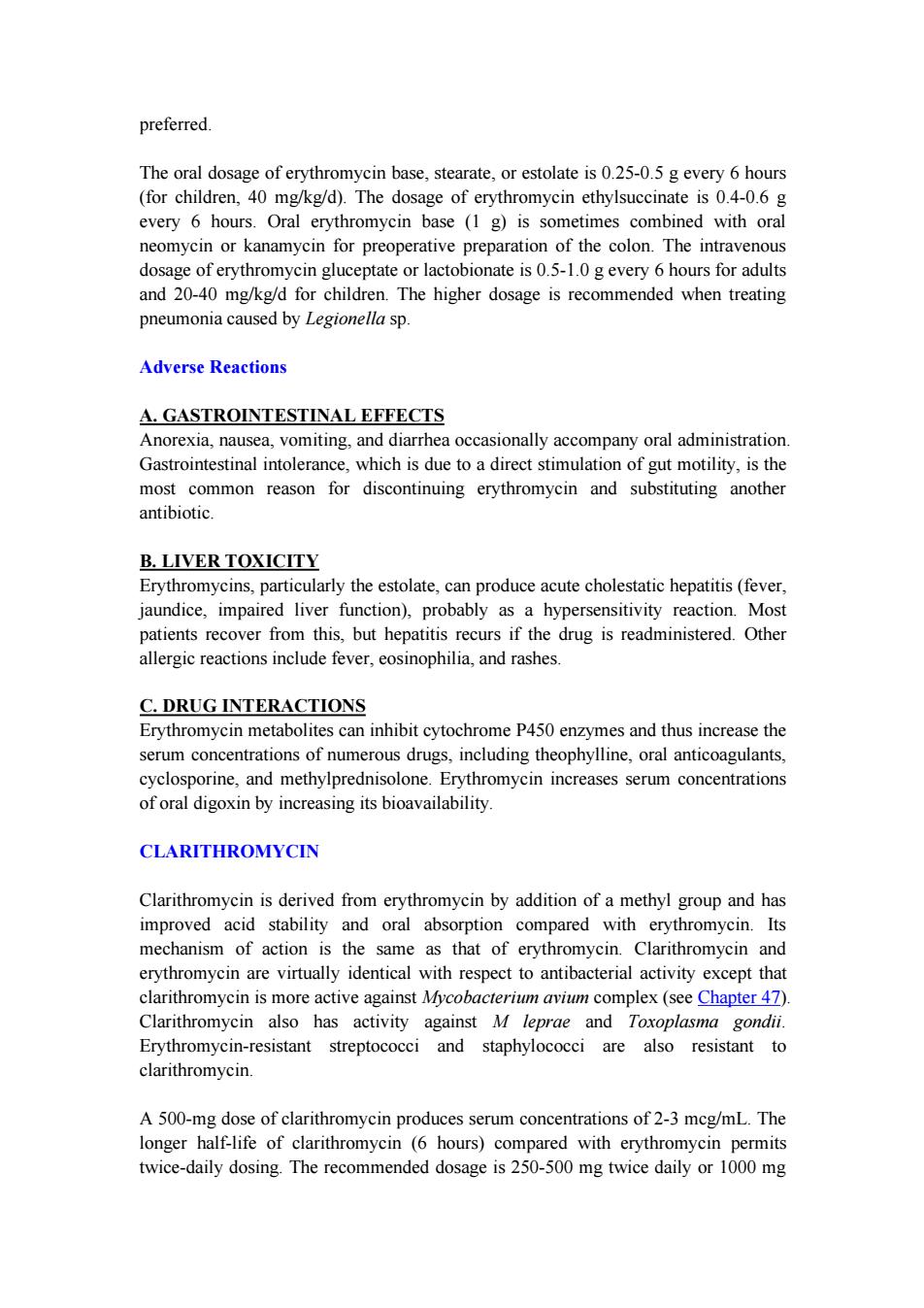
preferred. The oral dosage of erythromycin base,stearate,or estolate is 0.25-0.5 g every 6 hours (for children,40 mg/kg/d).The dosage of erythromycin ethylsuccinate is 0.4-0.6 g every 6 hours.Oral erythromycin base (1 g)is sometimes combined with oral neomycin or kanamycin for preoperative preparation of the colon.The intravenous dosage of erythromycin gluceptate or lactobionate is 0.5-1.0 g every 6 hours for adults and 20-40 mg/kg/d for children.The higher dosage is recommended when treating pneumonia caused by Legionella sp. Adverse Reactions A.GASTROINTESTINAL EFFECTS Anorexia,nausea,vomiting,and diarrhea occasionally accompany oral administration. Gastrointestinal intolerance,which is due to a direct stimulation of gut motility,is the most common reason for discontinuing erythromycin and substituting another antibiotic. B.LIVER TOXICITY Erythromycins,particularly the estolate,can produce acute cholestatic hepatitis(fever, jaundice,impaired liver function),probably as a hypersensitivity reaction.Most patients recover from this,but hepatitis recurs if the drug is readministered.Other allergic reactions include fever,eosinophilia,and rashes. C.DRUG INTERACTIONS Erythromycin metabolites can inhibit cytochrome P450 enzymes and thus increase the serum concentrations of numerous drugs,including theophylline,oral anticoagulants, cyclosporine,and methylprednisolone.Erythromycin increases serum concentrations of oral digoxin by increasing its bioavailability. CLARITHROMYCIN Clarithromycin is derived from erythromycin by addition of a methyl group and has improved acid stability and oral absorption compared with erythromycin.Its mechanism of action is the same as that of erythromycin.Clarithromycin and erythromycin are virtually identical with respect to antibacterial activity except that clarithromycin is more active against Mycobacterium avium complex (see Chapter 47). Clarithromycin also has activity against M leprae and Toxoplasma gondii. Erythromycin-resistant streptococci and staphylococci are also resistant to clarithromycin. A 500-mg dose of clarithromycin produces serum concentrations of 2-3 mcg/mL.The longer half-life of clarithromycin (6 hours)compared with erythromycin permits twice-daily dosing.The recommended dosage is 250-500 mg twice daily or 1000 mg
preferred. The oral dosage of erythromycin base, stearate, or estolate is 0.25-0.5 g every 6 hours (for children, 40 mg/kg/d). The dosage of erythromycin ethylsuccinate is 0.4-0.6 g every 6 hours. Oral erythromycin base (1 g) is sometimes combined with oral neomycin or kanamycin for preoperative preparation of the colon. The intravenous dosage of erythromycin gluceptate or lactobionate is 0.5-1.0 g every 6 hours for adults and 20-40 mg/kg/d for children. The higher dosage is recommended when treating pneumonia caused by Legionella sp. Adverse Reactions A. GASTROINTESTINAL EFFECTS Anorexia, nausea, vomiting, and diarrhea occasionally accompany oral administration. Gastrointestinal intolerance, which is due to a direct stimulation of gut motility, is the most common reason for discontinuing erythromycin and substituting another antibiotic. B. LIVER TOXICITY Erythromycins, particularly the estolate, can produce acute cholestatic hepatitis (fever, jaundice, impaired liver function), probably as a hypersensitivity reaction. Most patients recover from this, but hepatitis recurs if the drug is readministered. Other allergic reactions include fever, eosinophilia, and rashes. C. DRUG INTERACTIONS Erythromycin metabolites can inhibit cytochrome P450 enzymes and thus increase the serum concentrations of numerous drugs, including theophylline, oral anticoagulants, cyclosporine, and methylprednisolone. Erythromycin increases serum concentrations of oral digoxin by increasing its bioavailability. CLARITHROMYCIN Clarithromycin is derived from erythromycin by addition of a methyl group and has improved acid stability and oral absorption compared with erythromycin. Its mechanism of action is the same as that of erythromycin. Clarithromycin and erythromycin are virtually identical with respect to antibacterial activity except that clarithromycin is more active against Mycobacterium avium complex (see Chapter 47). Clarithromycin also has activity against M leprae and Toxoplasma gondii. Erythromycin-resistant streptococci and staphylococci are also resistant to clarithromycin. A 500-mg dose of clarithromycin produces serum concentrations of 2-3 mcg/mL. The longer half-life of clarithromycin (6 hours) compared with erythromycin permits twice-daily dosing. The recommended dosage is 250-500 mg twice daily or 1000 mg

of the extended release formulation once daily.Clarithromycin penetrates most tissues well,with concentrations equal to or exceeding serum concentrations. Clarithromycin is metabolized in the liver.The major metabolite is 14-hydroxyclarithromycin,which also has antibacterial activity.A portion of active drug and this major metabolite is eliminated in the urine,and dosage reduction (eg,a 500-mg loading dose,then 250 mg once or twice daily)is recommended for patients with creatinine clearances less than 30 mL/min.Clarithromycin has drug interactions similar to those described for erythromycin. The advantages of clarithromycin compared with erythromycin are lower incidence of gastrointestinal intolerance and less frequent dosing.Except for the specific organisms noted above,the two drugs are otherwise therapeutically very similar,and the choice of one over the other usually turns out to be cost and tolerability AZITHROMYCIN Azithromycin,a 15-atom lactone macrolide ring compound,is derived from erythromycin by addition of a methylated nitrogen into the lactone ring.Its spectrum of activity and clinical uses are virtually identical to those of clarithromycin. Azithromycin is active against M avium complex and T gondii.Azithromycin is slightly less active than erythromycin and clarithromycin against staphylococci and streptococci and slightly more active against H influenzae.Azithromycin is highly active against chlamydia. Azithromycin differs from erythromycin and clarithromycin mainly in pharmacokinetic properties.A 500-mg dose of azithromycin produces relatively low serum concentrations of approximately 0.4 mcg/mL.However,azithromycin penetrates into most tissues (except cerebrospinal fluid)and phagocytic cells extremely well,with tissue concentrations exceeding serum concentrations by 10-to 100-fold.The drug is slowly released from tissues (tissue half-life of 2-4 days)to produce an elimination half-life approaching 3 days.These unique properties permit once-daily dosing and shortening of the duration of treatment in many cases.For example,a single 1-g dose of azithromycin is as effective as a 7-day course of doxycycline for chlamydial cervicitis and urethritis.Community-acquired pneumonia can be treated with azithromycin given as a 500-mg loading dose,followed by a 250-mg single daily dose for the next 4 days. Azithromycin is rapidly absorbed and well tolerated orally.It should be administered 1 hour before or 2 hours after meals.Aluminum and magnesium antacids do not alter bioavailability but delay absorption and reduce peak serum concentrations.Because it has a 15-member (not 14-member)lactone ring,azithromycin does not inactivate cytochrome P450 enzymes and therefore is free of the drug interactions that occur with erythromycin and clarithromycin
of the extended release formulation once daily. Clarithromycin penetrates most tissues well, with concentrations equal to or exceeding serum concentrations. Clarithromycin is metabolized in the liver. The major metabolite is 14-hydroxyclarithromycin, which also has antibacterial activity. A portion of active drug and this major metabolite is eliminated in the urine, and dosage reduction (eg, a 500-mg loading dose, then 250 mg once or twice daily) is recommended for patients with creatinine clearances less than 30 mL/min. Clarithromycin has drug interactions similar to those described for erythromycin. The advantages of clarithromycin compared with erythromycin are lower incidence of gastrointestinal intolerance and less frequent dosing. Except for the specific organisms noted above, the two drugs are otherwise therapeutically very similar, and the choice of one over the other usually turns out to be cost and tolerability. AZITHROMYCIN Azithromycin, a 15-atom lactone macrolide ring compound, is derived from erythromycin by addition of a methylated nitrogen into the lactone ring. Its spectrum of activity and clinical uses are virtually identical to those of clarithromycin. Azithromycin is active against M avium complex and T gondii. Azithromycin is slightly less active than erythromycin and clarithromycin against staphylococci and streptococci and slightly more active against H influenzae. Azithromycin is highly active against chlamydia. Azithromycin differs from erythromycin and clarithromycin mainly in pharmacokinetic properties. A 500-mg dose of azithromycin produces relatively low serum concentrations of approximately 0.4 mcg/mL. However, azithromycin penetrates into most tissues (except cerebrospinal fluid) and phagocytic cells extremely well, with tissue concentrations exceeding serum concentrations by 10- to 100-fold. The drug is slowly released from tissues (tissue half-life of 2-4 days) to produce an elimination half-life approaching 3 days. These unique properties permit once-daily dosing and shortening of the duration of treatment in many cases. For example, a single 1-g dose of azithromycin is as effective as a 7-day course of doxycycline for chlamydial cervicitis and urethritis. Community-acquired pneumonia can be treated with azithromycin given as a 500-mg loading dose, followed by a 250-mg single daily dose for the next 4 days. Azithromycin is rapidly absorbed and well tolerated orally. It should be administered 1 hour before or 2 hours after meals. Aluminum and magnesium antacids do not alter bioavailability but delay absorption and reduce peak serum concentrations. Because it has a 15-member (not 14-member) lactone ring, azithromycin does not inactivate cytochrome P450 enzymes and therefore is free of the drug interactions that occur with erythromycin and clarithromycin